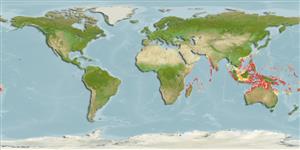Environment / Climate / Range
Ecology
Marine; reef-associated; non-migratory; depth range 11 - 45 m (Ref. 9790). Tropical, preferred ?
Indo-West Pacific: Somalia, Mauritius, Seychelles, Pakistan, Sri Lanka, Maldives, Chagos Archipelago, Indonesia, Philippines, Port Moresby, northern Queensland and New Caledonia. Reported from India (Ref. 45255).
Size / Weight / Age
Maturity: Lm ? range ? - ? cm
Max length : 24.0 cm TL male/unsexed; (Ref. 9790); common length : 15.0 cm TL male/unsexed; (Ref. 9790)
Dorsal
spines
(total): 9;
Dorsal
soft rays
(total): 11-12;
Anal
spines: 0;
Anal
soft rays: 11. Infraorbital and suborbital ridges bearing many fine serrations. Lower side of head unicarinate. Iris lappet bilobed. Caudal fin with dark basal band, whitish central band, blackish submarginal band becoming paler above, upper area usually with a few distinct dark spots.
Taken over sand around coral reefs to depths of 11 m; one specimen taken by trawl at 45 m (Ref. 9790). Also occurs on silty sand or rubble bottoms near reefs (Ref 90102).
Life cycle and mating behavior
Maturity | Reproduction | Spawning | Eggs | Fecundity | Larvae
Knapp, L.W., 1999. Platycephalidae. Flatheads. p. 2385-2421. In K.E. Carpenter and V.H. Niem (eds.) FAO species identification guide for fishery purposes. The living marine resources of the Western Central Pacific. Volume 4. Bony fishes part 2 (Mugilidae to Carangidae). FAO, Rome. (Ref. 9790)
IUCN Red List Status (Ref. 115185)
CITES (Ref. 94142)
Not Evaluated
Threat to humans
Harmless
Human uses
Fisheries: of no interest
More information
Common namesSynonymsMetabolismPredatorsEcotoxicologyReproductionMaturitySpawningFecundityEggsEgg development
ReferencesAquacultureAquaculture profileStrainsGeneticsAllele frequenciesHeritabilityDiseasesProcessingMass conversion
Tools
Special reports
Download XML
Internet sources
